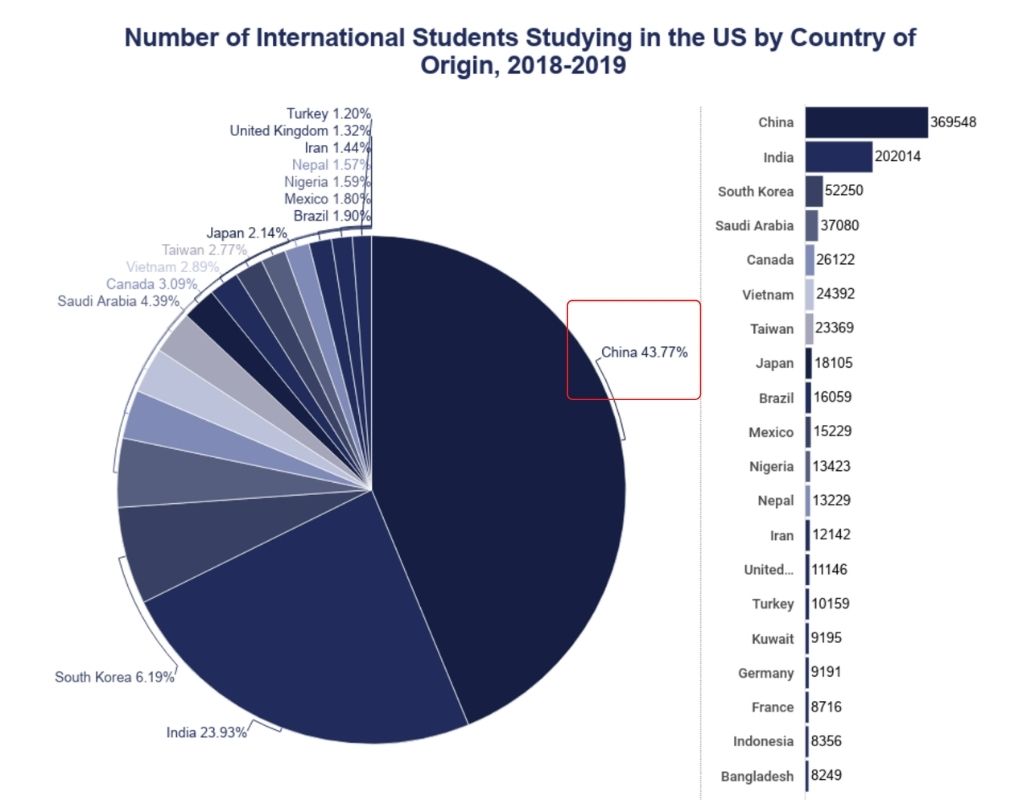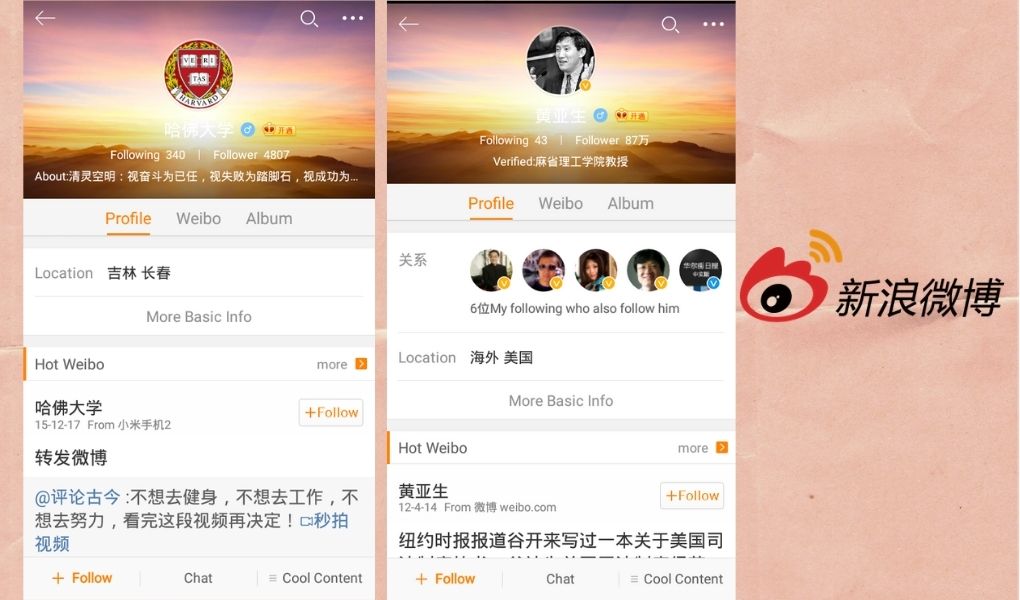US Education Businesses Should Invest in Digital to Get More Chinese Clients (2020)

China is the most promising education tourism market
With 662,100 Chinese students who went overseas in 2018, China is the biggest outbound education tourism market. The number increased by 11.74 percent compared to the previous year. The number of Chinese students going abroad to study keeps increasing.
According to the Ministry of Education of China, about 9 out of 10 Chinese overseas students financed their trip by themselves (usually parents) without any scholarship. The rest of the Chinese students are helped by their company or by a special government fund.
Cost-Effective Agency
KPI and Results focused. We are the most visible Marketing Agency for China. Not because of huge spending but because of our SMART Strategies. Let us help you with: E-Commerce, Search Engine Optimization, Advertising, Weibo, WeChat, WeChat Store & PR.
One interesting trend is that most of these students going abroad return home. In 2018, the total number of students coming back to China was 519,400, with a year-on-year increase of 8.01% compared with 2017. This number exceeded 600,000 in 2019.
Another trend is that they are younger and younger going towards high school and even middle school. The main destinations for Chinese students are mostly English-speaking countries: the US, Australia, and Canada.

Large number of Chinese students in the U.S.A.
China is the main market for US universities. In 2000, 10% of overseas students in the US were Chinese now 3 out of 10 foreign students are Chinese (304,040 Chinese students in the US). In 2019, there is a total of 369,548 Chinese students enrolled in the US. China has the highest student population in the US.
In 2005, there was about five times more Chinese graduate than undergraduate Chinese student. It has now totally shifted. Since 2014, there are now more Chinese students enrolled in Undergraduate programs than Graduate programs. The impact in 2018 on the US economy from Chinese student enrollment was $14.9 billion.
How American universities attract Chinese students?
SEO : visibility & optimization on Baidu
The most important thing for any education organization is to be visible to Chinese parents and students. A very powerful tool to search for information in search engines.
Just like any parent or student would look on Google for information about a university, Chinese just do the same. Since Google is forbidden in China, another search engine leads the market: Baidu.
Baidu is a Chinese search engine that owns more than 70% of the market. Needless to say, ranking in the first pages of Baidu will help you tremendously to be visible to Chinese students/parents/agencies.
As you can see on the screenshot, when we type “留学 ” (Study abroad) for example we only see international studies specialized website. Don’t hesitate to approach these websites to make your organization better known.
Create your own website for the credibility and Baidu SEO
If you want to apply Baidu SEO, it’s better to create your own website in Chinese and hosted in China or nearby like Hong Kong.
Why your website must be in Mandarin? Because Baidu only gives priority to Chinese websites. What’s more, if you want to provide your customers with a better user experience on your website, it is obligated to be hosted in China or nearby for a faster loading speed.
Also, be aware of the fact that Baidu’s SEO requirements differ from those for Google, which means the content and the design of your website should be created in the way that the Baidu SEO algorithm prefers.
Social Media : Wechat & Weibo boost your awareness
As of the first quarter of 2020, about 904 million people had access to the internet in China, resulting in a fast-growing mobile app market in the country. The main Chinese social media platforms are WeChat, Weibo.
WeChat is an instant messaging mobile app developed by Tencent (Creator of QQ). It has more than 1.2 billion active users worldwide in 2020 and China is the main market. Thanks to the community characteristic of Wechat, branding via Wechat can quickly create your brand credibility.
Weibo, with more than 550 million monthly active users, is a micro-blogging platform. It is also the largest open social media in China. It is very suitable for mass branding because all the content on the platform is free for everyone to see.
In recent years, KOL marketing in China is very popular, and Weibo has gathered a lot of KOLs. Almost every celebrity and influencer that you can name have an account on Weibo.
If you truly want to get closer to your audience and target market, Wechat and Weibo are a must. A university can have its own Official Wechat/Weibo page, just like the above picture shows, using a KOL (key opinion leader), an MIT professor who has more than 87 000 followers.
E-branding : invest in your e-reputation
Online branding is the use of a set of online strategy tools: search engine (SEO), social media (WeChat/Weibo), a Chinese website, presence on specialized Education websites, etc. Another important fact to take into account is the importance of Mian Zi (面子)in China.
Mian Zi which refers to “reputation” or “honor” is one of the basics of Chinese culture. Chinese people want to send their children to study abroad to show that their child is succeeding, can speak a foreign language, etc.
An education organization should share a story to really build a connection with the Chinese target customer. Having a page on the Baidu encyclopedia is a good start and will enable the school to share the story and values.
The Word of mouth : because Chinese care about others’ recommend
As of today, more than half of the Chinese population is connected to the Internet. The traditional way was to go offline by being present in conferences, giving lectures abroad, go sourcing in universities … Well, you can still do so but thanks to the wide availability of the Internet in China you can improve a school’s brand awareness by using digital tools.
Words, experiences, advice, feedback, and general information will flow and spread very fast across all social media platforms, websites, forums, and blogs. The school should just make sure that everything said is positive and should monitor the “spread” progress (even though it can be difficult).
Having a strong brand, building partnerships with local organizations, understanding the needs of the target market (Chinese parents, students), and providing value will help in the word-of-mouth process.
A Chinese student in the US was discriminated against by a Harvard University students back in 2015. A Chinese cooperative decided to defend her rights. As you can see this video has been seen more than 90,000 times since it was published !!
E-reputation is vital for your success in China
Thus, the importance of taking care of your reputation online should not be ignored. If an Australian university, for example, wants to attract more Chinese students, it should make sure that the image, how Chinese people perceive the organization is positive.
As you already know China is a very connected country. Moreover, people believe strongly in what is shared on the Internet. Having strong online testimonials, positive comments, and providing enough relevant information to Chinese parents/students will help Australian schools and universities to attract Chinese students.
Video testimonials attract Chinese students
Another way to attract more Chinese students is by using Chinese video platforms. In 2014, there were already more than 450 million video viewers which accounted for more than 5 billion hours of videos watched per month.
Also, According to Iresearch, in 2015, the Online Video market in China generated revenue of 11.53 billion Yuan (31.9% increase compared to the previous year). The main platform in China is Youku, Iqiyi, Tencent, and Sohu. Australian schools/universities could film their current Chinese students, post a video and then let the “word of mouth” happen by sharing the videos on several social media platforms.

As you can see below it is a great idea to have a video testimonial in Chinese by Chinese students. Actually, this university did a “mistake” by posting their video on YouTube (which is forbidden in China) but well the idea is there. The video should be posted on one of the main Chinese video platforms to give Chinese parents/students the chance to see the video.
Customer service: the last step but not least
Last but not least, if an Australian school wants to attract even more Chinese students, it should act as a business and ensure that Chinese customers are satisfied at every touchpoint.
The first touchpoint with the Chinese customer is when they are looking for more information about for example the school program or accommodation. Having someone who can speak Chinese and respond to parents’ queries, for example, is a great way to make them feel at “home”.
To learn more:
- Education in China – 7 strategies to generate leads
- The Top 5 digital strategies a good marketer must know in China …
10 Things Marketers Need to Know to master SEO on #Baidu ~> https://t.co/ojhv7pjmRJ | #China #SEO pic.twitter.com/hxqEEZr0cW
— ⒶⓁⒺⓧ. Beguel (@alebgl) 12 mai 2016











